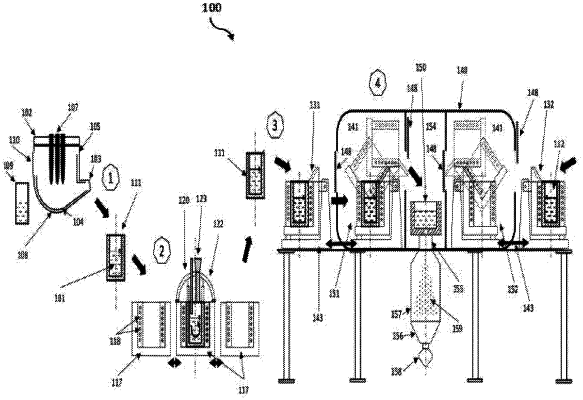| CPC B22F 9/082 (2013.01) [B22F 2009/088 (2013.01); B22F 2009/0848 (2013.01); B22F 2998/10 (2013.01)] | 8 Claims |

|
1. A method for producing atomized metal powders, comprising the steps of:
a) feeding raw materials comprising metal into a furnace;
b-1) melting the raw materials into molten metal;
b-2) removing impurities as a separate liquid slag layer forming on top of the molten metal within the furnace;
c) removing the molten metal from the furnace into a passively heatable ladle by tilting the furnace and pouring the liquid metal through at least one of a spout or tap hole formed in the furnace;
d) moving the passively heatable ladle full of molten metal into an inductively heated refining holding vessel, wherein the inductively heated refining holding vessel is configured to generate a first electromagnetic field and inductively produce heat inside the inductively heated refining holding vessel and further heat the molten metal inside the passively heatable ladle to thereby maintain the molten metal in a liquid state;
e) moving the inductively heated refining holding vessel through a refining station and applying a process of vacuum oxygen decarburization to remove undesirable impurities, inclusions or gasses from the liquid metal, while controlling the molten metal temperature with the first electromagnetic field by inductively heating the molten metal held inside the passively heatable ladle;
f) moving the passively heatable ladle from the inductively heated refining holding vessel into an inductively heated atomizer holding vessel located near a first receiving area of a gas atomizer, wherein the inductively heated atomizer holding vessel is configured to generate a second electromagnetic field and thereby inductively produce heat inside the inductively heated atomizer holding vessel via the passively heatable ladle to thereby maintain the molten metal in a liquid state;
g) moving the inductively heated atomizer holding vessel containing the passively heatable ladle through at least one atmosphere controlling door into the gas atomizer, while controlling the liquid metal temperature within the ladle by continually applying the second electromagnetic field to the inductively heated atomizer holding vessel to inductively heat the molten metal held by the passively heatable ladle, wherein the gas atomizer houses a controlled vacuum and inert atmosphere chamber;
h) tilting the inductively heated atomizer holding vessel within the gas atomizer to pour the molten metal from the passively heatable ladle into a tundish that is located in the controlled vacuum and inert atmosphere chamber within the gas atomizer, wherein pouring of the molten metal is at a controlled rate to maintain a minimum level of molten metal in the tundish while continuing to control the liquid metal temperature by applying the second electromagnetic field through the passively heatable ladle to the molten metal;
i) applying high pressure inert gas through a nozzle to a stream of liquid metal flowing out from the tundish into an atomizing chamber to produce a spray of droplets and form spherical shapes as the droplets cool and fall into a cone shaped bottom formed in the atomizing chamber; and
j) removing the spherical powder from the atomizing chamber through a discharge hopper.
|